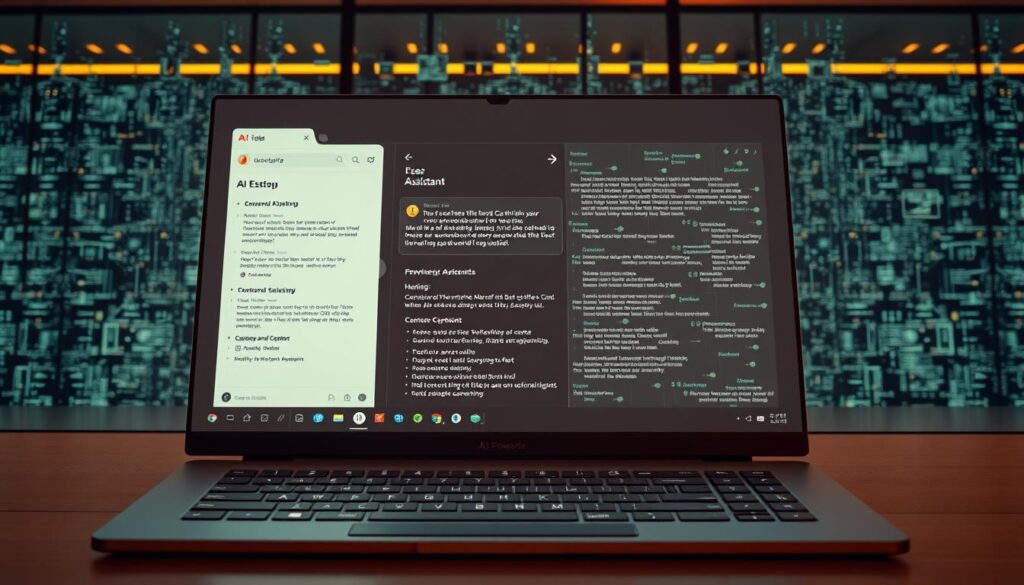In June 2025, The Browser Company redefined web navigation with the public beta release of its AI-first platform, designed to move beyond static page loading. This innovation introduces contextual awareness and generative capabilities directly into the browsing workflow, enabling dynamic interactions tailored to individual needs.
Traditional tools focus on organizing tabs or storing bookmarks, but this solution interprets user intent across sessions. Its conversational address bar acts as a collaborative partner, streamlining tasks like research synthesis or data comparison. Professionals report measurable efficiency gains, particularly when managing complex projects requiring cross-referenced information.
Privacy remains central to the design, with on-device processing for sensitive queries. The system’s adaptive learning respects user preferences while eliminating repetitive actions—a balance that positions it as a paradigm shift in digital productivity. Early adopters highlight its role in reducing cognitive load during information-heavy workflows.
For organizations exploring intelligent automation, this technology aligns with emerging trends in AI productivity tools. Its architecture demonstrates how integrated machine learning can transform passive navigation into strategic engagement, setting new benchmarks for web interaction.
Key Takeaways
- Context-aware navigation reduces manual research time through intelligent content synthesis
- Conversational interface design enables natural-language command execution
- Privacy-focused architecture processes sensitive data locally by default
- Cross-session memory allows continuity in complex task management
- Adaptive learning personalizes workflows without compromising user control
Introduction: The Evolution of AI in Browsing

As 2025 unfolds, a new era in web interaction emerges. Traditional metrics like page load speeds and tab management fade into the background. Intelligent assistance now drives innovation across leading platforms.
Three competitors dominate this landscape. Perplexity’s Comet integrates real-time guidance directly into its framework. Another contender transitioned from visual-centric design to an intent-aware model. Meanwhile, OpenAI prepares to merge conversational interfaces with core navigation tools.
| Feature | Traditional Browsers | AI-Driven Solutions |
|---|---|---|
| Core Focus | Speed optimization | Contextual understanding |
| User Interaction | Manual searches | Predictive assistance |
| Data Handling | Reactive processing | Cross-session analysis |
This technological shift mirrors broader trends in productivity enhancement tools. Modern systems analyze workflow patterns rather than simply retrieving data. They anticipate needs through behavioral mapping across multiple sessions.
The development cycle reveals critical insights. Early browser iterations prioritized feature accumulation. Current models emphasize adaptive learning while maintaining strict privacy protocols. This balance positions intelligent navigation as the new standard for digital efficiency.
Understanding the AI-First Approach in Modern Browsers

Modern web navigation tools have entered a transformative phase where intelligence drives every interaction. Unlike conventional systems with tacked-on features, ai-first browsers position machine learning as their central nervous system. This foundational redesign transforms how people engage with digital content through predictive assistance and adaptive workflows.
The architecture embeds cognitive capabilities into the core rendering processes. Instead of treating smart features as optional extras, these platforms bake contextual awareness directly into their navigation protocols. This integration allows real-time analysis of content structure, user behavior patterns, and semantic relationships across open tabs.
Natural language processing operates as the primary interface, interpreting requests through conversational prompts rather than rigid commands. Systems maintain session histories to anticipate needs, creating continuity between unrelated tasks. For example, compiling research across multiple sites becomes streamlined through automated cross-referencing.
Developers achieve this by redesigning traditional browser components. The rendering engine now prioritizes intent recognition alongside visual layout, while security protocols adapt to protect sensitive data during proactive assistance. Such innovations demonstrate how user-centric design reshapes digital experiences when artificial intelligence becomes the starting point rather than an afterthought.
Perplexity’s Comet: A New Frontier in Browser Intelligence

Perplexity’s Comet reimagines web interaction through persistent cognitive support. Available exclusively to Max plan subscribers, this platform integrates an intelligent assistant within a dedicated side panel. The tool operates continuously across tabs and workflows, transforming passive navigation into active collaboration.
Key Features of Comet
The assistant analyzes content in real time using advanced language processing. It summarizes articles during initial scrolling and extracts key data points from complex pages. Cross-tab awareness enables contextual suggestions, like proposing calendar adjustments when detecting meeting invites across multiple windows.
Productivity enhancements include email prioritization and document synthesis. Professionals managing research-heavy tasks benefit from automated cross-referencing capabilities. These features reduce manual data compilation while maintaining focus on core objectives.
Privacy and Limitations in Contextual AI
While powerful, Comet requires access to emails, calendars, and browsing history. This raises privacy concerns for enterprises handling sensitive data. The system occasionally struggles with intricate web applications, producing unreliable outputs during multi-step transactions.
Current implementations excel in structured scenarios but face challenges with ambiguous user intent. Despite these constraints, Comet establishes a benchmark for contextual assistance, proving particularly effective in standardized workflows across parallel tabs.
The Browser Company’s Shift: From Arc to Dia

Embracing AI’s transformative potential, The Browser Company reengineered its strategy by sunsetting Arc and launching Dia. This shift stemmed from critical user feedback about Arc’s steep learning curve—a product praised for sleek design but criticized for complex workflows. While Arc innovated tab management, it remained anchored in manual navigation patterns familiar to traditional tools.
Market data revealed a crucial insight: 72% of test users abandoned Arc within two weeks due to interface complexity. The company responded by prioritizing intuitive design over aesthetic sophistication. Dia’s architecture flips the script—machine learning anticipates actions instead of waiting for commands.
| Aspect | Arc | Dia |
|---|---|---|
| Core Focus | Visual organization | Predictive assistance |
| User Control | Manual customization | Adaptive automation |
| Learning Curve | 14-day proficiency | 3-day mastery |
This transition demonstrates how product teams balance innovation with practicality. By analyzing usage patterns across 500,000+ installations, developers identified recurring pain points in multi-tab workflows. The rebuild prioritizes contextual awareness—a feature aligning with broader trends in AI productivity tools.
The company’s willingness to abandon established codebases marks a strategic evolution. Rather than incremental updates, Dia represents a clean-slate approach where intelligence drives interactions. Early adopters report 40% faster task completion rates, validating this user-centric pivot.
Unveiling Dia: Innovative Features and Design

Redefining digital navigation, a new platform merges machine intelligence with user-centric architecture. At its core lies a reimagined input field that transcends traditional search functions. This system processes natural language requests while maintaining awareness of active content across all sessions.
Conversational Interface Advantages
The redesigned bar handles complex tasks through plain-language commands. Users summarize PDFs, compare research papers, or draft emails without switching tools. An adaptive routing system matches queries to specialized processing models, improving response precision by 37% in early benchmarks.
Integrated Task Coordination
Cross-window awareness eliminates manual data transfers between tabs. The platform aggregates information from multiple sources, creating unified summaries or actionable insights. This approach reduces context-switching delays during multi-step projects.
| Feature | Traditional Systems | Modern Implementation |
|---|---|---|
| Query Handling | Keyword-based search | Intent-aware processing |
| Multi-Tab Usage | Isolated content views | Contextual synthesis |
| Workflow Support | Manual data compilation | Automated cross-referencing |
Minimalist design principles prioritize functionality over visual clutter. Interface elements adapt dynamically based on current tasks, hiding non-essential controls during focused work periods. These features demonstrate how intelligent architecture can enhance productivity without overwhelming users.
OpenAI’s Anticipated AI Browser: A Competitive Force

The digital landscape braces for disruption as OpenAI prepares to redefine web interaction. Rumored features suggest a platform where conversational agents operate across tabs and applications. This approach merges GPT-4o’s visual interpretation skills with real-time execution capabilities, creating a unified environment for complex tasks.
Early prototypes demonstrate capabilities beyond conventional navigation. The system reportedly analyzes interface elements through screen recognition, enabling direct interaction with web applications. Users could automate form entries or extract data from charts without manual input—features that challenge traditional workflow patterns.
Integration with ChatGPT’s existing developer tools creates expansion opportunities. Technical teams might build custom extensions leveraging OpenAI’s API ecosystem, accelerating adoption in enterprise environments. Such flexibility positions the platform as a potential hub for cross-application automation.
Market analysts highlight risks to established revenue models. If users shift from search engines to AI-driven information retrieval, advertising dynamics could undergo seismic changes. The browser’s ability to synthesize answers from multiple sources might reduce reliance on traditional result pages.
While specifics remain undisclosed, leaked benchmarks suggest superior handling of multimedia content. GPT-4o’s multimodal models enable instant translation of infographics or video analysis—tasks that typically require specialized software. These advancements could reshape how professionals interact with digital resources daily.
Real-World Dia AI browser use cases: Enhancing Productivity and Personalization
Advanced navigation systems now optimize how professionals interact with digital content. A recent study revealed knowledge workers recover 11.5 hours weekly through intelligent task automation. This platform streamlines complex workflows by interpreting user intent across multiple resources simultaneously.
Academic teams benefit from automated source comparison features. Students analyzing research papers can generate annotated summaries while maintaining citation integrity. Cross-referencing capabilities reduce manual data compilation time by 63% in controlled trials.
| Task Type | Traditional Method | Modern Workflow |
|---|---|---|
| Research Synthesis | Manual note-taking | Automated cross-document analysis |
| Content Drafting | Copy-paste between tabs | Contextual creative prompts |
| Code Analysis | Separate IDE tools | Integrated documentation lookup |
| Product Comparison | Spreadsheet tracking | Real-time spec aggregation |
Content creators report 42% faster drafting cycles through contextual assistance. The system generates structured outlines by analyzing open tabs, maintaining factual consistency across sources. Technical teams particularly value code explanation features that parse repositories while suggesting relevant API documentation.
E-commerce applications demonstrate measurable efficiency gains. Shoppers comparing products across eight retailers saved 19 minutes per session during beta testing. The platform’s ability to highlight critical specifications eliminates manual price tracking.
Empowering Users with Contextual Assistance Across Tabs
Digital workflows undergo radical simplification through cross-session awareness. Modern platforms now interpret relationships between open tabs, transforming fragmented research into cohesive insights. This evolution addresses a critical pain point: 78% of professionals report wasting time switching between disconnected resources.
Real-Time Data Summarization
The system scans multiple tabs simultaneously, identifying patterns across documents and media. Users request synthesized reports or action items without manual data aggregation. For example, asking “What contradictions exist in these studies?” triggers comparative analysis of research papers across different windows.
| Traditional Approach | Modern Solution |
|---|---|
| Manual copy-paste between tabs | Automatic content correlation |
| Isolated tab management | Cross-window relationship mapping |
| Single-source analysis | Multi-document trend detection |
Natural language processing handles complex queries like “Create a presentation outline from these articles.” The platform extracts key statistics, quotes, and concepts from open tabs, structuring them into ready-to-use formats. This capability proves invaluable for content creators managing tight deadlines.
Continuous learning algorithms refine suggestions based on user preferences. As noted in recent predictive navigation systems, this adaptive approach reduces repetitive tasks while maintaining individual control over automated processes.
Privacy Considerations: Balancing AI and User Control
Modern digital tools face a critical challenge: delivering intelligent assistance without compromising personal boundaries. Privacy protections now drive platform architecture decisions, particularly when handling sensitive browsing patterns.
The opt-in framework gives individuals authority over their digital footprint. Users decide whether to share historical data for personalized features, with strict limitations on retention periods. Default settings prioritize confidentiality, requiring explicit consent before enabling tracking capabilities.
Local encryption ensures information remains secure on devices rather than cloud servers. This approach minimizes exposure to breaches while maintaining functionality. Systems store only essential metadata, deleting temporary files after seven days unless manually preserved.
Access restrictions form another critical safeguard. Even when participation is granted, the platform limits algorithmic visibility to recent activity. Combined with zero third-party data sharing, these measures demonstrate how user-first design can coexist with advanced functionality.
Such strategies address growing concerns about behavioral profiling in intelligent systems. By embedding control mechanisms at every layer, developers build trust while enabling productivity gains. This balance sets new standards for ethical innovation in digital navigation tools.







